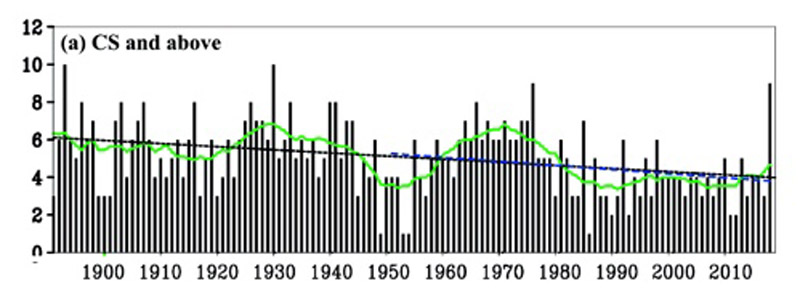By Vijay Jayaraj,
Reports of climate change affecting our world are made every day. Sometimes, those doing the reporting use selective data and cherry-pick short term trends to drive home a doomsday narrative.
This is very much true with the claims surrounding extreme weather events. In the U.S., for example, long-term data on show a decline in the number of hurricanes making landfall. However, most mainstream media never report this fact.
Worldwide, numerous such exaggerations and misrepresentations are made regularly. This includes my country of India, where climate change is said to be causing both droughts and floods.
It is possible that you have seen the mainstream media project images of submerged cities in South Asia or detailed opinion columns highlighting how farms in India are dying from droughts. The blame for such disasters is placed squarely on a changing climate and emissions of carbon dioxide from burning fossil fuels.
However, 150 years of data – as far back as it goes — on summer monsoon rainfall reveals that both droughts and floods have long been regular occurrences on the Indian subcontinent, with no major departures in recent decades.
India: A Key Nation in Global Climate Debate
India, which has a population of 1.3 billion, holds a prominent place in the global politics of climate change. The country will soon become the most populous in the world, It is becoming a very large consumer of fossil fuels and is one of the largest agricultural producers.
Any adverse effect of climate change on the country’s weather would be felt directly by more than 17 percent of the world’s population. Many more millions who depend on India’s agricultural output would also be affected. Thankfully, rainfall data from the country’s renowned meteorological center shows no marked departure in precipitation trends.
The graph below shows the area-weighted mean summer monsoon rainfall, based on a homogeneous data set of 306 rain gauges in India from the Indian Institute of Tropical Meteorology. This is the most reliable index of summer monsoon activity over the Indian region since 1871.

Figure: All-India Summer Monsoon (June-September) Rainfall (AISMR) Anomalies during 1871-2017. Source: Indian Institute of Tropical Meteorology, Government of India. https://www.tropmet.res.in/~kolli/mol/Monsoon/Historical/air.html
During the period 1871-2015, there were 19 major flood years, with none since 1995. There were 26 major drought years between 1871 and 2015, with only five of them between 1995 and 2015. None of those recent droughts were as intense as some that were witnessed before the 1900s.
Experts note that it is quite difficult to associate the rainfall pattern with climate change or even with other well-known global weather phenomenon such as the ENSO oscillation patterns in the ocean. Monsoon rainfalls display epochal trends (short term trends) that are random, with some decades (1921-1964) being influenced by ocean oscillations while other decades (1965-1987) remaining largely unaffected.
Further, the Indian government’s comprehensive “Assessment of Climate Change over the Indian Region” points out that there is no increase in extreme cyclones due to man-made global warming/climate change.
In fact, there has been a decrease in cyclone frequency since 1950. The report says, “Long-term observations (1891–2018) indicate a significant reduction in annual frequency of tropical cyclones in the North Indian Ocean basin.”

Figure: Annual Frequency of Cyclonic Storm between 1891 and 2016. Linear trend lines are indicated by dashed lines—black (1891–2018), blue (1951–2018). Also, 10-year running mean is shown by a solid-green line. Source: Extreme Storms, Indian Meteorological Department, Govt. of India. Published June 13, 2020.
In layman terms, there has been no dangerous increase or decrease in India’s summer monsoon rainfall or the cyclones in the region.
Yes, increasing agricultural activity in traditionally drought-prone arid zones and the lack of drainage infrastructure in metropolitan cities are real problems, but they have nothing to do with the climate. Extreme droughts, floods, and cyclones were regular occurrences in the past and the frequency pattern has displayed no dangerous departure in the recent decades.
===
Vijay Jayaraj is a Research Associate at the CO2 Coalition, Arlington, Virginia. He holds a master’s degree in environmental sciences from the University of East Anglia, UK and resides in India.
Tags: Commentary




















Join the conversation!
We have no tolerance for comments containing violence, racism, vulgarity, profanity, all caps, or discourteous behavior. Thank you for partnering with us to maintain a courteous and useful public environment where we can engage in reasonable discourse.